Karmann Ghia Factory Assembly
Special thanks to Jeff MacMillan for providing scanned images from the following 1969 brochure... #33-14-96010, printed by VW.
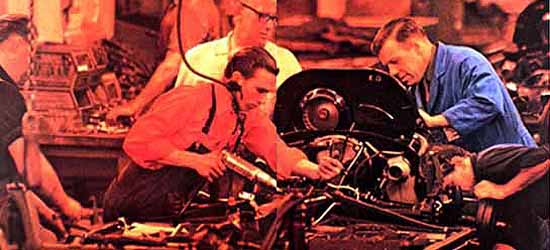
|
|
Engines from the VW plant in Hannover, gearboxes from the VW plant in Kassel, rear axles and frames from the VW plant in Wolfsburg, front axles from the VW plant in Brunswick: they all meet here in Osnabrück at the Karmann coachworks to make the chassis for the VW Karmann Ghia. (Now you know where the VW in Karmann Ghia comes from.) Karmann is one of the oldest custom coach makers in Europe. In 1874 they were working rare woods and expensive leathers into one-of-a-kind coaches for the European nobility. And when the automobile was invented, they turned to car bodies, building for Adler, Hanomag, Hansa, and Mercedes-Benz to name some of their customers. Right now they're making the body for the Porsche Fastback on a line next to the Karmann Ghia's. We farm out our bodywork to Karmann for a simple reason: the handwork that goes into a sculptured Ghia body takes such an interminable time (on a good day Karmann can turn out only 208 Ghias), we'd be crazy to tie up our production lines making our curvy little car. So we throw the curves to Karmann. They have 240 inspectors along the line to make sure every Ghia is up to Karmann standards. (That's one of them above in the blue smock.) We have 16 VW inspectors to make sure every Karmann Ghia is up to VW standards. That's one of ours (right) in the gray smock at the end of the production line. So if there's ever a question whether a Ghia is up to snuff, the gray smocks have the last word. |
 |
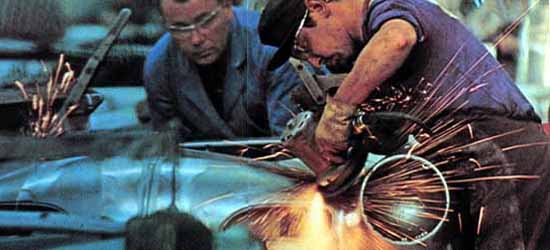
|
|
When the Karmann Ghia first appeared in 1955, Road & Track called it the Ghia Karmann. Which may have been their way of saluting the designer - the Ghia studios of Turin, Italy - for a car R&T described as having "an almost universal appeal to the eye." What gives the Ghia its classic good looks are its simple, uncluttered lines. .. lines which are anything but simple to achieve. In order to create those sharp curves around the headlight housings, each fender is made in two sections. Welded together by hand. And shaped down by hand. Then the fenders are hand-welded to the body with long, continuous seams of metal. And the welds are sanded and burnished till they gleam. The test comes when the inspector pulls on his cotton mitten and feels where the body ends and the fenders begin. If his left hand tells him the front assembly is made of one continuous piece of smooth steel, he knows it's right. |
 |

|
|
Some of the Karmann Ghia's lines are impossible to form on a press. Or by welding together two pieces of steel. So they're sculptured instead. The man at right is one of Karmann's 16 sculptors. It's his job to create the sweeping lines at the corners of the windshield. The metal he uses is pewter - expensive English pewter - and after it becomes workable at 350 F., he shapes it with a beechwood tool into the line our Italian designer insisted upon. Now sculptors aren't machines. (Neither are the men, above, who put a finishing touch on the sculpting and smoothing.) So it's safe to say they'll never turn out two Karmann Ghias exactly alike. In this day and age, some people would consider that an achievement. |
 |
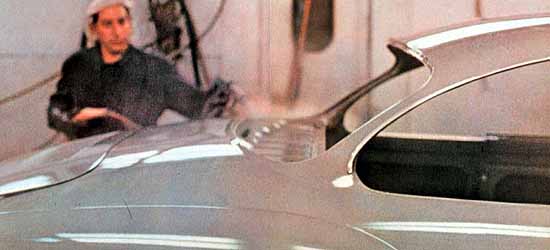
|
|
After the sculptors come the painters. First they spray on a rustproof, anticorrosion coat of zinc phosphate. Then they submerge each Ghia body in a tank of paint so that every inch of metal is covered. Inside and out. Then comes a paint undercoat (right) to toughen up the wheel wells for the extra abuse they take. Followed by a hand-sprayed third coat. A hand-sprayed color-base primer coat. And, finally, a hand-sprayed enamel color coat. Five coats in all. In between, the body is baked four times and sanded down by hand three times. What we end up with is a finish that's impervious to weather for years. Even longer if you give it the care a piece Italian sculpture deserves. |
 |
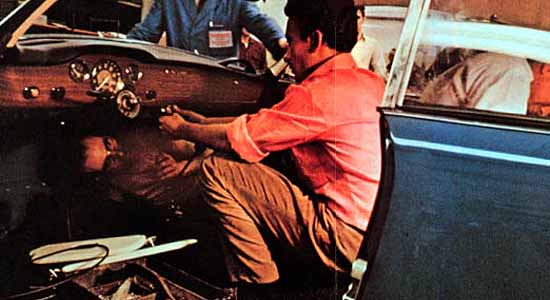
|
|
The Karmann Ghia's interior is finished off with the same care. The dashboard is padded with a cushion of foam rubber and covered with leatherette. Knobs on the dash and window handles are made of soft rubber. Door handles are recessed in the doors. There are three defrosters, two in front and one in back. Four heating outlets that can be controlled individually: front left, front right, and two in the rear. A fresh-air ventilation system. And as with all VW products, the heater defroster is standard equipment. Some other standard items: locks to anchor the bucket seat backrests in place, and front and rear bonnets that can only be unlocked from inside the car. There's a little metal plate that pops up when you pull out the ashtray. It's there to protect the instrument panel from a direct hit with a hot cigarette. If you took apart the glove compartment door, you'd find that the interior surfaces had been sanded and painted . . . metal that was never meant to be exposed. Why? To prevent rusting that would never be seen. Before a Ghia leaves the Karmann factory it's hand-sprayed (right) with a paraffin solution to protect it on the trip across the Atlantic. We leave nothing to chance. |
 |

|
|
When a Karmann Ghia comes off the boat, it heads straight for an authorized Volkswagen dealer. (There are about 1000 of them in the United States.) This is as it should be: all the parts that make a Ghia go are straight out of the VW. This gives the Karmann Ghia owner a tremendous advantage over the drivers of those other sexy-looking imports. Getting parts is no problem. Factory-trained mechanics are as close as your nearest VW dealer. So are 250 special tools built to fit only VW parts. (Like the gauge at the right for measuring the alignment of the front axle beam.) There are some adventurous souls who may feel we've taken all the sport and thrill out of owning a Karmann Ghia. (The same people who objected when we installed our first gas gauge in 1957.) But we wouldn't have our service operation run any other way. And neither would you. |
 |
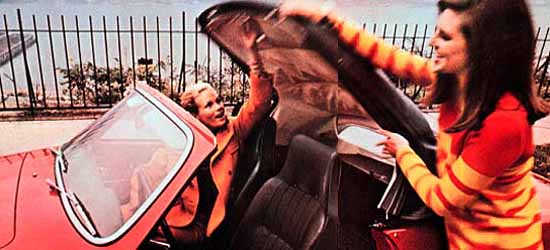
|
|
The Karmann Ghia convertible top is hand-padded, hand-fitted, and hand-stitched to the frame. It takes two men four hours to make one. It would take longer except they sew with curved needles; they get around corners quicker that way. The inch-and-a-half of rubber and horsehair padding keeps noise out and heat in. But most people buy convertibles to keep the top down. This one hooks down snugly in back. And in case of a sudden thunderstorm, you don't have to worry about the top getting stuck half-way up. It's powered by the most I reliable machine going. You. The instrument panel is simple, gadget-free, and easy to read. It contains a speedometer that tells you how fast you're going, an odometer that tells you how far you've gone, a fuel gauge that tells you how far you can go, and an electric clock. If you require a tachometer, vacuum gauge, or other exotic instrumentation, you'll have to buy them. We left plenty of room on the dashboard for improvisation. |
 |
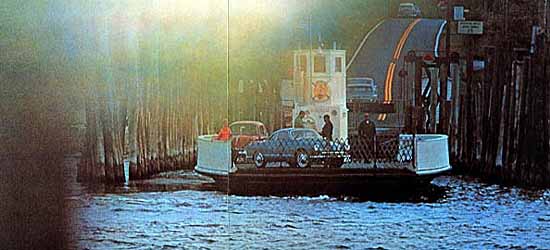
|
|
When you consider all the handwork that goes into a Karmann Ghia, you'd expect it to cost an arm and a leg. It doesn't. You pay about $550 more than the man who buys a VW Sedan. And when it comes to operating economy, you're both in the same boat. Average Karmann Ghia gas mileage is 28 on a gallon of regular gasoline. About 40,000 miles to a set of tires isn't unusual. You buy oil by the pint. Not the quart. But you never buy antifreeze because the engine is cooled by air. There's no water in it to freeze. Or boil So even if you bought a two-tone model (they're about $20 more than our one-tone Ghias) you'd still save enough not to think twice about taking it to the car wash every week. To the cleaners it will never take you. |
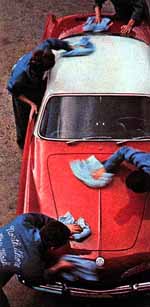 |
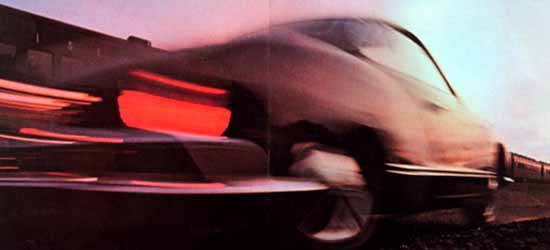
|
|
The Karmann Ghia can reach a top speed of 82 mph with its 1500 c.c. air-cooled engine. You get there by shifting up through the four gears of the synchromesh transmission. This four-speed transmission lets you pick the gear that's most efficient for every driving situation. It provides maximum control over your car at all speeds. To stop your car there's a dual brake system. Disc brakes in front. Drum brakes in back. If one set should ever fail, the other continues to operate. This tight personal control extends to the steering where a hydraulic damper soaks up shock before it can reach the steering column. The steering wheel can't be shaken from your hand. (New this year: an impact-absorbing steering column and steering wheel.) Another fact that won't shake you up: the Ghia's wheels are independently sprung by torsion bars so that a jolt to one wheel can't be passed along to another wheel. Result: you always ride with your Ghia under a firm rein. Your local VW dealer will be happy to give you a free test drive at your convenience. But please don't bring anyone along for the ride except your best girl (or boyfriend). We figured there ought to be some place left in this busy world to escape to. So the Karmann Ghia was designed to seat only two adults. Three's a crowd. In the end, that may be the most beautiful thing about it. |
 |
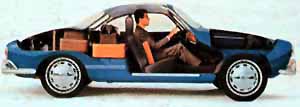
|
The cutaway photograph shows why we call the VW Karmann Ghia a
two-seater. We buckle up the driver and his front seat passenger in
bucket seats that adjust to any of 15 seating positions. (Five
front-to-rear adjustments and three seat back adjustments.) With the
seats in their rearmost position, passengers get a surprising amount of
legroom up front. But there's not much room left in back for a person
to stretch his legs. So we suggest you fold down the backrest and use
the space on the rear bench seat to carry things like suitcases, golf
clubs, scuba gear, or camping equipment instead. They're lots more fun
than a backseat driver. |
|
Engine: 4-cylinder, 4-stroke, O.H.V. type VW engine, rear--mounted. Bore 3.27 in. Stroke 2.72 in. Displacement 91.1 cu. in. 53 HP at 4200 R.P.M. S.A.E. Compression ratio 7.5:1. Automatic choke. Cooling System: Air cooling by fan: thermostatically con- trolled. Oil cooler in air stream. Transmission: Synchromesh on 1st, 2nd, 3rd and 4th gears. Short sports-type stick shift. Final drive: Power transmitted through spiral bevel gear and differential gear via two swing axle shafts to rear wheels. Chassis: Tubular center section forked at rear with welded-on platform. Footbrake: Hydraulically operated dual braking system with self-adjusting disc brakes on front wheels and drum brakes at rear. Front and rear systems work independently. (Warning light on dashboard.) Overall dimensions: Length 163.0 in. Width 64.3 in. Height 9.4 in. Fuel tank capacity: 10.6 U.S. gal. Performance: about 28 miles per U.S. gal. Max. and cruising speed 82 mph. Tires: 5 tubeless, 5.60x15. Electrical system: 12-volt with 45 amp. battery. 10-fuse capacity fuse box. Standard equipment: Two front seat belts, outside rearview mirror, leatherette upholstery, door pockets and padded armrests, recessed door handles. Two-speed windshield wipers with pneumatic washer. Electric clock. Two back-up lights. Emergency flasher. Optionals: Whitewall tires. Accessories: Radio with antenna, cigarette lighter, walnut gearshift knob, underdash parcel shelf, cocoa floor mats, air conditioner, tonneau cover for convertible. And much more. Ask your authorized VW dealer to show you his complete accessory line. SPECIFCTIONS SUBJECT TO CHANGE WITHOUT NOTICE VOLKSWAGENWERK AG., WOLFSBURG, GERMANY |
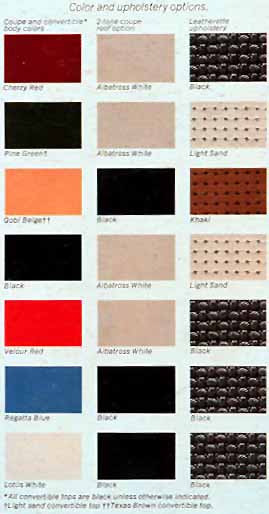 |
|
OUR 2-YEAR/24,000 MILE WARRANTY. If the owner
maintains and services the vehicle in accordance with the Volkswagen
maintenance schedule and obtains a validation stamp on his Maintenance
Card every twelve months, and if any part of a new Volkswagen becomes
detective within 24 months or 24,000 miles after delivery, whichever
comes first, any authorized United States or Canadian Volkswagen dealer
to which the customer delivers the car, will repair or replace the
defective part free of charge for material and labor with a new or
factory reconditioned part, provided the customer presents the dealer
with the validated Maintenance Card and provided, further, that the
defective part has not become so due to normal wear and tear, exposure,
misuse, accident or by the installation of non-genuine Volkswagen parts
or by the repair of the car by someone other than an authorized
Volkswagen dealer. nor does warranty cover for normal maintenance
service such as fuel system cleaning and wheel, brake or clutch
adjustment, replacement of service items such as spark plugs, ignition
points, V-belts wiper blades or brake and clutch linings and the
deterioration of upholstery soft trim or appearance items. |